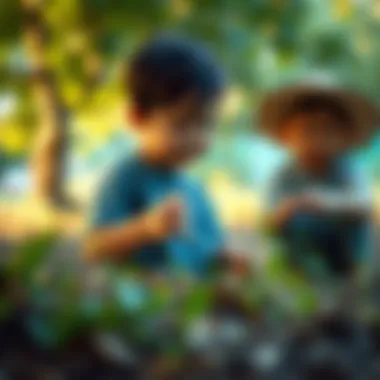Engaging Climate Change Trivia for Kids


Nature Topic Overview
Understanding climate change often feels like a daunting task, but it doesn't have to be! This article is like a treasure map leading children through the fascinating world of climate change, helping them unearth exciting facts while learning about the planet they call home. We want to engage minds aged five to twelve and pique their interest, showing how even small actions can lead to a healthier planet.
Climate change happens when the Earth's atmosphere warms up. You might wonder why that matters. Well, each one of us plays a part! From the food we eat to the energy we use, these daily choices create ripples that shape our environment. This guide introduces fundamental elements like the greenhouse effect and the value of biodiversity, all through tales and trivia that young ones can relate to.
Fun Facts and Trivia
Did you know that every truckload of groceries you see can be linked to climate change? Here are some fun nuggets of info that are sure to pique the interest of any young learner:
- The Greenhouse Effect: Think of it like a warm blanket. Gases like carbon dioxide trap heat, making Earth cozy but too cozy is a problem!
- Polar Bears: These magnificent creatures roam the icy Arctic, but their homes are melting away due to rising temperatures.
- The Ocean’s Role: The world’s oceans are like a sponge absorbing excess carbon dioxide. However, they too are getting warmer.
Visual aids such as colorful infographics can transform dry facts into engaging visuals. Kids can shout, "Wow!" when they grasp the idea that their footprint can either be light as a feather or as heavy as a mountain!
Wildlife Explorations
The biodiversity of our planet is astounding! Think about vibrant rainforests bustling with life, or coral reefs that look like underwater cities. Here’s a glimpse into the incredible variety of species affected by climate change:
- Coral Reefs: These living structures are the homes to thousands of species. But rising ocean temperatures are causing coral bleaching.
- Endangered Species: From the snow leopard in the Himalayas to the black rhino in Africa, many animals are struggling to survive as their environments change.
Consider interactive quizzes asking kids questions like, "How can you help a polar bear?" or puzzles featuring images of different habitats. This not only reinforces learning but makes it enjoyable too.
Environmental Awareness
Preserving our environment is crucial. But how can kids step up to the plate? Here are some essentials:
- Conservation: It's about caring for natural resources. Teach kids about simple acts, like turning off lights when leaving a room.
- Sustainability: This means using resources responsibly. For example, when making lunches, think reusable bags instead of plastic ones!
"Every little bit counts! Even the smallest hands can help in big ways."
Encouraging them to engage in clean-up activities can be a fun way to make an immediate impact. Everyone can chip in, just like a team!
DIY Nature Activities
Let’s roll up those sleeves! Hands-on activities can turn learning into a fun adventure. Here are some practical examples:
- Plant a Seed: Show how plants absorb carbon dioxide and release oxygen. A small pot and some seeds could grow into a beautiful science experiment!
- Create a Nature Journal: Kids can document their findings on local flora and fauna, learning while enjoying the outdoors.
A step-by-step guide to creating a bird feeder from pinecones and peanut butter can also engage kids in observing nature up close.
- Outdoor Explorations: Take them on a nature walk and observe changes in the environment. Let them spot signs of wildlife or plant growth!
These activities not only deepen understanding but also cultivate a sense of connection with the Earth that they will carry with them.
Understanding Climate Change
Understanding climate change is more than just a buzzword; it’s like peeking behind the curtain to see how our world works and evolves. This section aims to break down essential ideas about climate change, making them digestible and relatable for young minds.
Why does this matter? First, knowing what climate change is can instill a sense of responsibility in us all, especially kids who are the stewards of the future. By learning about these changes today, children can grasp the importance of small actions—like recycling, conserving water, and planting trees—on a larger scale. They hold the power to make a difference!
The intriguing journey through this topic will also spark curiosity and engagement; kids will learn that even the most complex scientific concepts can be understood with the right approach. So, buckle up! This enlightening expedition starts now.
What is Climate Change?
In simple terms, climate change refers to any significant change in the average temperature and weather patterns over time. It’s like when you notice that summer is suddenly feeling hotter or winter is shorter and milder than it used to be. These shifts happen naturally, but right now, human activities are putting the pedal to the metal, speeding up these changes.
Key Points:
- The Earth's atmosphere is always fluctuating, but human actions, like burning fossil fuels and deforestation, are playing a huge role in increasing temperatures.
- The term 'climate' encompasses conditions over years and decades, while 'weather' refers to daily atmospheric conditions.
The Greenhouse Effect Explained
Have you ever felt a warm breeze when walking into a greenhouse? That’s because glass traps heat inside. The same principle applies to Earth’s atmosphere. The greenhouse effect occurs when gases in the atmosphere, known as greenhouse gases, trap the sun’s warmth. Some of these gases, like carbon dioxide, are necessary to keep our planet warm enough to sustain life. Without them, our planet would be a frozen ball of ice!
However, nowadays, we’re releasing more of these gases than ever before. Imagine a blanket getting thicker and thicker—it keeps getting warmer under there! That’s why scientists are concerned.
"The greenhouse effect is essential for life as we know it. But too much of a good thing can lead to problems!"
Natural vs. Human-Induced Changes


Nature has its own rhythm, and climate has always been changing. For instance, millions of years ago, there were no polar ice caps at all! Natural events, like volcanic eruptions and solar variations, can cause changes in climate over long periods. These natural influences are a bit like nature’s dance—rhythmic and somewhat predictable.
On the other hand, human-induced changes are like crashing the party. Activities like industrial emissions, excessive livestock farming, and land use changes push the climate beyond natural variability. The balance has shifted.
Differentiating Factors:
- Natural changes are part of Earth’s cycles, while human-induced changes accelerate the warming trends.
- Both contribute to changes, but the rate and extent of change caused by humans are unprecedented in modern history.
By understanding these differences, we can appreciate how vital it is to cooperate with our planet rather than against it.
Historical Context
Understanding the historical context of climate change is important because it helps us see how changes in the Earth's climate have been happening long before people started keeping records. By looking back at Earth's climate history, young minds can understand that climate change isn't just a modern-day issue—it's a constant in the Earth's timeline. This knowledge can inspire curiosity and a deeper appreciation for the planet.
When children learn about climate change's history, they also learn about the science behind it. They can draw connections between what happened in the past and what is happening today. This connection can help them understand the significance of their actions and choices in the present and future.
A Glimpse into Earth's Climate History
Earth is like a giant clock that has seen many seasons. Its climate has changed throughout its 4.5 billion-year history. There were moments called ice ages, when the planet was covered in ice and snow, and then there were warmer periods, when plants and animals flourished. These changes occurred naturally and were influenced by things like volcanic eruptions and shifts in the Earth's orbit.
For instance, about 650 million years ago, the Earth went through a really cold period known as the Snowball Earth, where nearly the entire planet froze over. Can you imagine how different it looked back then? On the flip side, around 55 million years ago, the planet experienced a warm spell called the Paleocene-Eocene Thermal Maximum. During this time, even polar regions were tropical!
Recognizing that our climate has swung from warm to cold and back multiple times helps us understand that the Earth has an incredible resilience. This history shows that while climate can change naturally, the speed and causes of today's climate changes are different because of human actions.
Milestones in Climate Science
As scientists began exploring our planet and its atmosphere, they made crucial discoveries that moved our understanding of climate change forward. One of the most important milestones was in 1856 when an American scientist named Eunice Foote discovered that the carbon dioxide we breathe out traps heat in our atmosphere. This shedding light on the greenhouse effect was a game changer.
Fast forward to the 20th century, where in the 1970s, people started worrying more about air pollution and its effects. It was a turning point that led to the creation of the Environmental Protection Agency in the U.S. in 1970. Soon after, in 1988, the Intergovernmental Panel on Climate Change (IPCC) was established by the United Nations. The goal was to provide scientific evidence about climate change to world leaders.
Here are some fascinating milestones:
- Eunice Foote's discovery in 1856: Showed that carbon dioxide traps heat
- The first Earth Day in 1970: Raised awareness about environmental issues
- Formation of the IPCC in 1988: Brought climate change to the forefront of global discussions
- The Paris Agreement in 2015: Countries agreed to work together to limit global warming
These milestones aren't just dates on a calendar; they represent growing awareness about our climate and the necessity for action. Young people today can harness these lessons from history to champion change and contribute to a more sustainable future.
Nature's Signs
Understanding nature’s signs is a vital part of grasping climate change. These signs help us see how our planet is reacting to its changing environment. For younger audiences, recognizing these signs can spark curiosity and create a stronger bond with Mother Nature. A child's awareness of climate indicators can encourage them to think critically about the world around them. This section will dive into the various indicators we can observe in nature and how shifts in animal behavior serve as essential clues about climate change.
Indicators of Climate Change
When we talk about indicators of climate change, we're referring to types of evidence we can see in the environment. Here are a few examples:
- Temperature Records: Over decades, we can see that average global temperatures have been climbing. It might sound boring, but think about how a hot day feels! That's like our Earth trying to tell us something.
- Weather Patterns: Extreme weather events, like stronger hurricanes or unusual snowfall, also point to changes. Each odd weather event is like a puzzle piece showing the bigger picture.
- Glacier Retreat: Glaciers, those giant ice blocks, are shrinking. If you ever see pictures of glaciers today compared to just a few decades ago, it’s kind of eye-opening. The ice is melting faster than a popsicle on a steaming summer day.
- Migration Patterns of Animals: Animals don’t just wander for fun; they have homes they depend on. Changes in their migration patterns can hint at shifting climates. If birds arrive earlier in spring or head back south later, those are not just changes; they're signals.
Observing these indicators can teach us how and why the planet is heating up.
Recognizing these signs means we’re not just watching. We become part of the story of Earth's climate journey.
Animal Behavior and Climate Change
Animals have their own way of communicating, and one significant message is how they alter their behavior in response to climate change. For instance:
- Breeding Seasons: Some species breed earlier as spring arrives sooner. If a bear is waking up from hibernation earlier, it might be looking for food. This change affects not just the bears but everything in the food web!
- Feeding Habits: Changes in food availability can change what an animal eats. If flowers bloom earlier, insects that rely on them might emerge earlier, potentially confusing predators that depend on them.
- Habitat Moving: Animals like polar bears are being affected as ice melts. They need a solid ice base to hunt seals. Less ice means more difficulty finding food, which can lead to far-reaching consequences.
Understanding animal behavior in relation to climate change provides insight into how disruptions affect the entire ecosystem. It underscores the interconnectedness of life; when one creature struggles, it can create a domino effect.
In summary, paying attention to both nature's signs and the behaviors of animals gives us powerful clues about what's happening to our planet. It urges everyone, especially children, to engage with these changes and inspires a sense of responsibility for protecting our world.
Effects of Climate Change
Understanding the effects of climate change is critical for everyone, especially children. When young minds grasp how our world is changing, they can start to think about solutions and their roles in protecting the environment.
Impact on Weather Patterns
Weather patterns are like a giant puzzle that fits together to create a picture of the Earth’s climate. However, climate change is moving some of those puzzle pieces around. For example, regions that used to have mild winters might experience blizzards out of the blue. Conversely, places that were usually rainy may face droughts.
The shifts aren’t just random. Scientists have observed:


- Increased frequency of extreme weather events like hurricanes and tornadoes.
- Changes in rainfall distribution, causing floods in some areas while leaving others dry.
- Warmer temperatures leading to longer heatwaves.
It’s fascinating yet concerning. Such changes can disrupt birds migrating south for the winter or affect crops that rely on predictable seasons to grow. Children can learn that the weather they experience is tied to a much larger story—one that involves the delicate balance of nature and human impact.
The Melting Polar Ice Caps
Imagine giant ice cubes slowly drifting in a drink. Over time, those ice cubes melt and change the taste of the drink. That’s what’s happening at the North and South Poles. The polar ice caps are melting, which has serious implications.
This melting ice has several consequences:
- Rising temperatures: As ice caps disappear, dark ocean water is exposed, absorbing more heat instead of reflecting it back. This process warms the planet further.
- Wildlife habitat lost: Animals like polar bears and seals rely on the ice for hunting and resting. Without it, their survival is at risk.
- Global sea rise: The water from the melting ice caps flows into oceans, causing sea levels to rise, which can threaten coastal communities.
By learning about this, kids can find inspiration in how important it is to keep the ice where it belongs.
Rising Sea Levels: Causes and Consequences
Did you know the Earth’s oceans are getting bigger? This phenomenon, known as rising sea levels, affects many areas around the globe. It’s primarily caused by two things: melting ice caps and thermal expansion of water as it heats up.
Here’s why it matters:
- Coastal areas may experience flooding more frequently. Children might have heard about storm surges that drown beaches they love to visit.
- As saltwater invades coastal areas, it can harm plants and drinking water supplies.
- Communities have to face tough choices about where to build houses and protect land.
The upside is kids who understand this can step up! They can share their knowledge about how planting trees, conserving water, and using public transport can help slow down these trends.
"Education is not preparation for life; education is life itself."
By educating young readers about the effects of climate change, we inspire a generation aware of their environment. They become part of the solution, thinking about practical measures they can implement in daily life.
Biodiversity and Ecosystems
Biodiversity and ecosystems form the backbone of our planet’s health and function. They are crucial not only for maintaining the balance of nature but also for supporting life itself, including human life. In simple terms, biodiversity means the variety of living things including plants, animals, fungi, and micro-organisms. It encompasses the different habitats they live in, like forests, oceans, and rivers. For kids, think of it like a giant puzzle; each creature and plant is a piece that fits together to make a beautiful picture.
Why is Biodiversity Important?
Biodiversity has tremendous benefits. It provides us with food, clean water, and medicines. Many curious little explorers might not know, but lots of the fruits we love to eat, like apples and bananas, come from diverse ecosystems. These ecosystems help regulate temperatures and weather patterns, which is even more important as climate change shakes things up. So, without a variety of living organisms, life would be harder, and some things we take for granted could vanish!
"Biodiversity is the spice of life. It's not just about surviving; it's about thriving!"
Threats to Biodiversity
Even though biodiversity is essential, it faces a slew of threats that are concerning. One major culprit is habitat destruction. As cities expand and forests are cut down, many species lose their homes. Think about it: if you were forced to move out of your cozy nook because a big building took over, you wouldn’t be too happy, huh?
Another threat is pollution. Chemicals in our rivers and oceans can be deadly to fish and other aquatic animals. Some young readers might be interested to know that plastic pollution is a hot topic right now. Sea turtles often mistake plastic bags for jellyfish, leading to dire consequences.
Lastly, climate change itself is a looming threat. With changing weather patterns, some species struggle to adapt and keep up. For instance, polar bears rely on sea ice for hunting seals, their main source of food. If that ice melts away, it becomes harder for them to find meals and care for their young.
Key Threats:
- Habitat destruction
- Pollution
- Climate change
Ecosystem Resilience in a Changing Climate
Now, let’s flip the script and look at something hopeful: ecosystem resilience. This means how well ecosystems can bounce back from stress and change. Many ecosystems have a remarkable ability to adapt. For example, certain forests can regenerate after being logged if they are given enough time and care. It’s all about the balance.
Youth may find it uplifting to know that scientists and conservationists are doing tremendous work to help ecosystems. Restoration projects are underway all around the globe to revive damaged habitats. By planting trees, cleaning up polluted areas, and creating protected zones, we ensure that nature has a fighting chance.
Moreover, learning about how local species interact in communities can reveal just how interconnected everything is. Even small changes can ripple through the ecosystem, affecting other plants and animals. The more we protect biodiversity, the stronger our ecosystems become.
In summary, while biodiversity faces significant threats mostly caused by human activities, the resilience of ecosystems offers a glimmer of hope. Young minds can play a pivotal role in protecting our planet. Remember, a little action goes a long way in ensuring a vibrant world teeming with life.
Mitigation Strategies
In the face of climate change, mitigation strategies represent a road map of hope and action. These strategies are essential because they help us counteract the effects of climate change and work towards reversing some of the damage already done. But what does mitigation really mean? It’s about finding ways to reduce greenhouse gas emissions and enhance the resilience of our ecosystems. By engaging young minds, we can inspire the next generation to take these issues to heart and act thoughtfully in their everyday lives.
Before we dive deeper, let's remember something important: every small effort counts. So whether you’re turning off the lights when leaving a room or using a reusable water bottle, these actions add up! Now, let’s explore how we all can play our part in this significant mission.
How We Can Help
There’s a treasure trove of actions that kids and adults alike can take to contribute to mitigation. Here are some practical ways:
- Reduce, Reuse, Recycle: Get into the habit of reducing your waste. It’s not just a catchy phrase; it’s a lifestyle! Find ways to reuse items rather than tossing them away. And remember recycling is more than just a buzzword; it helps save energy and resources.
- Plant Trees: Trees are nature’s air filters. They absorb carbon dioxide and release oxygen. Plus, they can provide shade and shelter for many creatures. Gather your friends or family and see if you can plant some trees in your neighborhood to improve your environment.
- Conserve Water: Water is a precious resource! Turn off the tap while brushing your teeth, and try to take shorter showers. Every drop saved counts.
- Use Public Transport, Walk, or Bike: Rather than hopping in the car for short journeys, consider using public transport, walking, or biking. It’s healthier for you and the planet!


"Little actions taken by many can lead to significant change. "
Each one of these actions not only helps mitigate climate change but also inspires those around you to think similarly. By showing commitment to the earth, kids can become real role models.
Renewable Energy Sources
The shift to renewable energy sources holds the key to a sustainable future. Unlike fossil fuels, which release harmful gases when burned, renewable energy comes from natural processes that replenish themselves, such as sunlight, wind, and water. Here are a few forms of renewable energy:
- Solar Energy: Harnessing the sun’s rays can produce electricity for homes, schools, and businesses. Solar panels, those shiny gadgets you see on rooftops, can reduce reliance on fossil fuels.
- Wind Energy: Wind turbines harvest the power of the wind and convert it into electricity. You might have seen those tall towers spinning peacefully in the countryside. They contribute greatly to cleaner air.
- Hydroelectric Power: By using the flow of rivers and dams, we can generate electricity without polluting the environment. Just think about all that water power!
- Bioenergy: This energy comes from organic materials—like plant matter or animal waste. It’s a way to turn leftovers into something useful, like electricity or heat.
All these sources hold promise for our future and help mitigate the negative impacts of climate change. Transitioning to renewable energy not only lessens our carbon footprints but also fosters innovation, creating jobs and boosting local economies.
It’s exciting to think about how embracing these strategies today can inspire kids to feel a sense of agency. They’re not just passive observers; they’re active participants in shaping a healthier planet for all.
The Role of Young Activists
As they say, "actions speak louder than words." Young activists are making quite a bang when it comes to climate change. With their energy and determination, they spark discussions and awaken the collective consciousness on this pressing issue. Why is this important? Because children, who will inherit the planet, have a unique perspective. When they speak up or organize, they’re not just participating; they’re teaching everyone around them to pay attention and act.
Young activists come from diverse backgrounds and cultures, bringing different ideas to the table. They often embrace a collective approach, where working together can bring about change faster than going solo. Their voices can challenge traditional beliefs and reignite conversations that have stalled. This ability to shake things up makes their role crucial in the fight against climate change.
There are many benefits to involving young people in activism. First, they are digital natives. Their familiar environment equips them to use social media and technology effectively. They can reach vast audiences lightning-fast and share compelling stories that inspire action. From TikTok campaigns to Instagram posts, their reach knows no bounds.
Additionally, young activists often possess boundless enthusiasm. Their passion makes it easier for them to engage their peers. It’s infectious! When a young person rallies their friends, the excitement can spread like wildfire. They instill hope and remind others that every little action counts.
Still, young activists face challenges too. Their lack of experience can sometimes lead to hurdles. However, they often learn quickly and find innovative solutions. With guidance from mentors—like parents, teachers, or community leaders—they can navigate these obstacles effectively.
"Act for your future, because tomorrow is yesterday's dream"—this notion resonates deeply with young activists.
Inspiring Change: Youth Movements
Youth movements have gained momentum in recent years, capturing attention for various causes, particularly climate change. The youth are participating in marches and rallies, demanding immediate action from leaders. What does engaging in such movements mean? It’s more than just showing up; it’s about voicing their rights and responsibilities toward the Earth. Young activists bring an energy and perspective that older generations might overlook.
For instance, take the global Fridays for Future movement. Initiated by Greta Thunberg, a Swedish teenager, this campaign has become a beacon for many young activists worldwide. Kids skipping school to stand for their beliefs drew the eyes of news outlets and mainstream society. They shouted, "We need to act now!"
So, how can young people get involved? Here are a few ways:
- Join local climate groups: Participating in community discussions or volunteer activities.
- Organize or participate in marches: Mobilizing friends, family, or classmates to make their voices heard.
- Spread awareness online: Using social platforms to share ideas, articles, and their thoughts on climate change.
- Initiate school projects: Proposing eco-friendly initiatives at school, like recycling programs or tree-planting days.
By stepping up, young activists are not just painting pictures of problems—they’re brainstorming solutions. They’re making climate change relatable and actionable, helping everyone, young or old, recognize the need for sustainable living. Stand-up for the planet? They’re already doing it, and it’s a sight to behold.
Innovations for the Future
Innovative thinking is like planting seeds for a sustainable future. It’s essential for tackling climate change and building a healthier planet for our kids, grandkids, and beyond. Young minds can grasp the idea that new technologies and creative ideas can help us learn better ways to treat our Earth. Through innovation, we can find solutions to problems that seem as challenging as climbing a mountain!
Whether it's improving energy sources or figuring out how to reduce waste, the innovative spirit among young people and inventors around the globe can spark exciting changes. Learning about these innovations can inspire children to think differently and maybe one day, design their own solutions!
Technological Advances in Combatting Climate Change
Technology is advancing faster than a cheetah on the prowl. Science and engineering are busy coming up with tools that can save our environment. One remarkable technology is the development of solar panels. These panels catch sunlight and turn it into energy.
- Solar Farms: These are large areas covered in solar panels that produce clean energy, reducing dependence on fossil fuels.
- Wind Turbines: Tall and twisty structures that catch the wind's power to create electricity.
Another innovative idea is carbon capture technology. In simple words, this means taking carbon dioxide out of the air and storing it somewhere safe. It works like a big sponge, soaking up bad stuff to keep our air cleaner.
"If you think about the power of innovation, it's like having a superhero on our side against climate change."
Lastly, electric vehicles are transforming how we travel. Unlike regular cars that burn petrol, these run on electricity and produce less pollution. Kids today might dream of a future where everyone drives quiet, clean cars!
Creative Solutions from Around the World
Around the globe, creative thinkers are stepping up to the plate, hitting home runs for the planet with innovative ideas to lessen climate change.
- Vertical Gardens: Cities often have limited space, so some are growing gardens on walls! These gardens not only provide fresh food but also cool the buildings and clean the air.
- Trash to Treasure: Some artists and inventors repurpose waste, turning old plastic bottles into beautiful art or useful items. This showcases how recycling can be both practical and pretty.
- Community Clean-ups: Kids, parents, and teachers can organize groups to clean up parks and beaches. Not only do trash-free areas look nice, they protect animals too!
Ending
Summarizing the importance of awareness around climate change is not just an afterthought; it's the backbone of understanding how our little acts can create a big rippling effect across the globe. In this article, we’ve unraveled the layers surrounding what climate change truly is, explored how it impacts our wildlife and ecosystems, and highlighted how we, even as young readers, play vital roles in combating it.
Summarizing the Importance of Awareness
The core of raising awareness about climate change lies in the idea that knowledge is power. Young minds, with their natural curiosity, can spread this knowledge like wildfire—encouraging not only their peers but also adults to think about their environmental footprint. Teaching kids about climate change helps them realize:
- Connection to Nature: Understanding that every living thing is linked; when one aspect is affected, others follow suit.
- Empowerment Through Action: Just simple steps like using less water, throwing away trash correctly, or even planting a tree can make a significant impact.
- Future Habitats: Knowledge instills a sense of responsibility to protect the places all creatures call home. The brighter their awareness shines, the more likely we are to see a sprout of change.
"An ounce of prevention is worth a pound of cure."
This famously quoted idiom rings true here. If we arm our future generations with knowledge, we allow them to prevent further damage to our planet rather than just resolve issues that have already sprouted. By cultivating this awareness, we are gifting them the tools needed not only to survive but to thrive amid ongoing environmental challenges.







